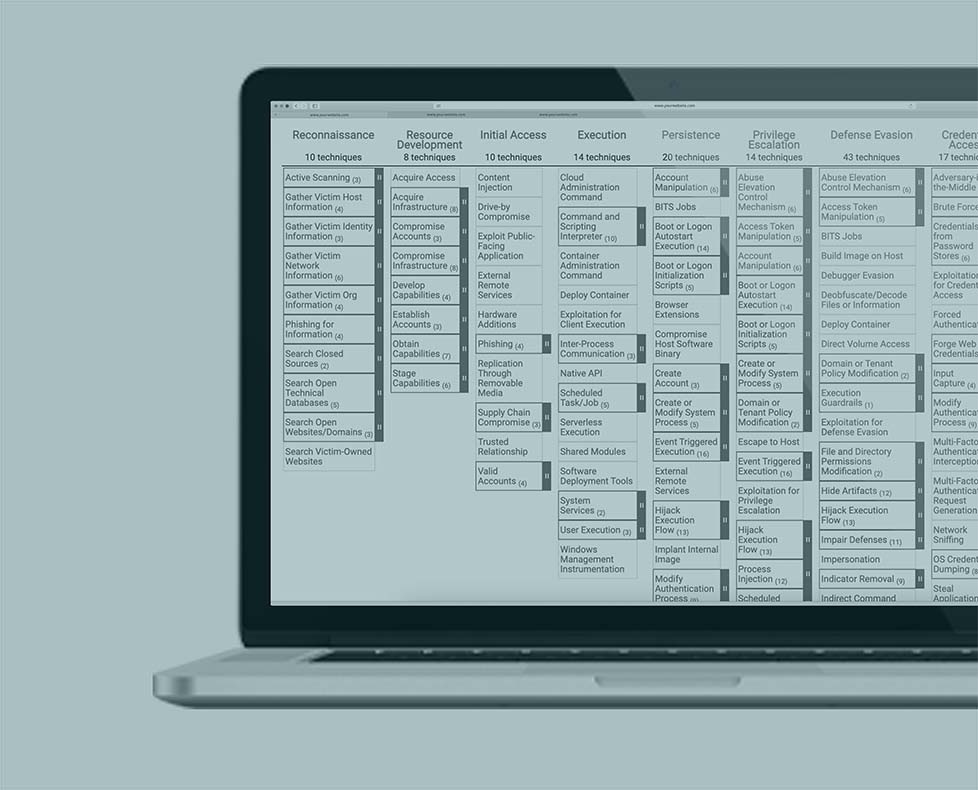RED TEAM
See your organization through the eyes of an experienced attacker
With our Red Team exercise, simulate a sophisticated attack to assess the resilience of your systems, employees and infrastructure.
Discover potential vulnerabilities and assess your ability to detect advanced attacks.
Strengthen your defenses to better anticipate real threats.
Simulate a full Red Team attack to test your defenses
Our ethical hackers simulate a realistic cyberattack, adopting the techniques of a real adversary. Their mission: to hit predefined targets using creative and unpredictable tactics, undetected by your defense team, the Blue Team.

PHYSICAL ENVIRONMENT
Test your organization’s physical security
Determine whether unauthorized persons can access your critical infrastructure or information.

CYBER ENVIRONMENT
Get a complete assessment of your defense
Identify vulnerabilities that only real attackers could exploit. We test your defense and your Blue Team.

HUMAN ENVIRONMENT
Determine whether your employees are following best practices
Analyze your employees’ cybersecurity behaviors.

Decipher the path of attackers with the MITRE ATT&CK framework
Our experts use the MITRE ATT&CK framework to help you understand exactly how attackers conduct Advanced Persistent Threats (APTs). By adopting this standardized language, we facilitate clear communication between your teams and reinforce your cybersecurity strategy. By reproducing attackers’ tactics, we give you a concrete vision of the risks specific to your organization, so you can better anticipate and counter them.
Need a Red Team?
A Red Team exercise takes around 35 days spread over 8 weeks, with prices starting at €17,500 excluding VAT.
Contact us today for a customized quote and to strengthen your organization’s security.
What is a Red Team in cybersecurity?
In the field of cybersecurity, the Red Team refers to a team of elite ethical hackers, whose mission is toimitate the behavior of a real attacker to test the resilience of an information system, a network, an application or even an entire organization. Unlike traditional security audits or pentests, which are often limited in time, scope and methodology, the Red Team approach is comprehensive, multidimensional and unannounced. The team can employ a variety of techniques, such as social engineering, targeted phishing, exploitation of technical vulnerabilities, physical compromise of infrastructures or bypassing detection devices.
The aim is not simply to identify vulnerabilities, but to demonstrate, with evidence, how a malicious actor could achieve a strategic objective such as accessing sensitive data, compromising a privileged account or disrupting an essential service. The Red Team generally works in a controlled environment, with the approval of senior management, but without informing operational teams, in order to test their ability to detect, analyze and react to a sophisticated attack.
What are the different missions of a Red Team?
The missions entrusted to a Red Team are defined according to the strategic objectives of the test, the organization’s level of cyber maturity and the criticality of the assets to be protected. These missions are part of a ” red teaming” approach, based on realistic, goal-oriented attack scenarios. For example, the Red Team may seek to penetrate an internal network from an external access point, escalate its privileges to gain access to a sensitive server, or bypass perimeter defense mechanisms to demonstrate a flaw in the surveillance system. It can also be aimed at specific targets such as the accounting department, system administrators or senior management, with the aim of simulating data exfiltration or internal fraud.
Red Team missions also include assessing staff awareness of manipulation techniques, the resistance of internal processes to compromise, and the responsiveness of SOC (Security Operations Center) teams to abnormal behavior. The advantage lies in the real-life setting, where all the means available to the attacker are simulated to test structural flaws, whether human, technical or organizational.
What is the methodology of a Red Teaming exercise?
A red teaming exercise is based on a rigorous, structured methodology governed by precise rules. It always begins with a phase of defining objectives, in close collaboration with the organization’s decision-makers, who set limits, critical perimeters, authorized targets and expected results. Next comes the reconnaissance phase, during which the Red Team gathers as much information as possible about its target, through open sources (OSINT), passive scans or attack surface analysis. This stage is crucial for identifying intrusion opportunities without alerting defenses. Once the entry vectors have been defined, the Red Team moves on to theexploitation phase, where it uses offensive techniques to compromise systems, access data or break into internal network segments. This phase may include the use of customized malware, backdoors, privilege elevation techniques or pivoting attacks to stealthily advance into the targeted computer system.
The exercise also includes a persistence phase, during which the Red Team installs mechanisms to maintain prolonged access, just like real advanced threats. At the same time, it is careful to remain invisible, to test the ability of detection tools to identify abnormal activity. Finally, once the objectives have been reached or the allotted time has elapsed, the reporting phase begins, during which the Red Team submits a detailed account of its actions, the vulnerabilities exploited, the data compromised, the systems infiltrated and recommendations for improvement. This report then serves as the basis for the work of the Blue Team, responsible for reinforcing the defenses.
What's the difference between Red Team and Pentest?
Confusion between Red Team and penetration testing is common, but these two approaches have very different methodologies, scopes and objectives. A pentest, or penetration test, aims to identify as many technical vulnerabilities as possible on a given system, within a short timeframe and with a clearly defined scope. It is an exhaustive process, aimed at detecting exploitable vulnerabilities, often followed by a report containing a risk ranking and the corrective measures to be applied.
In contrast, a Red Team takes a strategic, focused and realistic approach. It doesn’t try to find everything, but to achieve a specific objective using the methods of a real attacker. It mobilizes a complete attack chain, integrating human (social engineering, phishing), logistical (physical access, identity theft) and technical (vulnerability exploitation, privilege escalation) dimensions.
Where pentesting reveals vulnerabilities, Red Team demonstrates how they can be exploited in real-life situations, often undetected. It simulates a complete intrusion, over several weeks, with phases of rest, reactivation and persistence, and sometimes interacts with physical security devices (access badges, video surveillance), making it a broader, more immersive approach.
What are the benefits of Red Teaming?
This type ofexercise enables a company or public authority to take a concrete measure of its cyber-resilience in the face of targeted, stealthy attacks. It reveals security blind spots, highlights configuration errors, weaknesses in procedures or staff training gaps. It validates the effectiveness of detection tools (SIEM, EDR, firewall), the responsiveness of incident response teams, and the coordination between the various cybersecurity players. By testing a complete scenario, from the initial intrusion to the achievement of the objective, Red Teaming offers a holistic vision of the security posture.
It also helps to reinforce the company’s in-house cybersecurity culture, to identify those employees most at risk from social engineering, and to focus future cybersecurity investments on areas of real priority. Finally, it creates a strong awareness effect, showing management in a concrete and factual way the real impact of a successful cyberattack.
